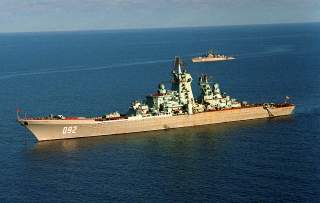Russia's Navy: Modernizing but Where Are the Aircraft Carriers and Battlecruisers?
But no aircraft carrier? No battlecruiser?
A coterie of new ships at Russia’s annual Navy Day Parade in Saint Petersburg reflects the rapidly changing face of the Russian Navy as it forges ahead with a far-reaching modernization program.
First established in 1939 as an annual Soviet holiday to “mobilize the working masses around the construction of a Workers’ and Peasants’ Soviet Navy,” Navy Day was canceled in 1980 and reinstated in 2006 by presidential decree of Vladimir Putin. However, it was not until 2017 that Saint Petersburg was designated as the permanent site of the main Naval Parade that has since served as a staging post for the Russian Navy to display flagship hardware intermixed with historical vessels.
First, a few notable omissions. Russia’s geriatric, problem-ridden Admiral Kuznetsov aircraft carrier was unsurprisingly missing from the event, as it is reportedly undergoing extensive repairs on the heels of a devastating devastating drydock crane incident late last year. More curious is the absence of the Petr Velikiy (Peter the Great) battlecruiser, the world’s largest surface military vessel and the star of the 2017 Navy Day Parade. However, the exclusion of Petr Velikiy makes ample sense in the context of a 40-strong parade lineup that sought to reflect the Russian Navy’s gradual transition into a lean, local, rapid-response force.
Occupying a prominent place in the parade’s spearhead was the second Admiral Gorshkov-class frigate, Admiral Kosotonov, coming it at a displacement (vessel weight) of 4,500 tons and armed with Russia’s unique Paket-E/NK anti-submarine/anti-torpedo system. Also present was Gremyashchiy, the flagship of the new Gremyashchiy heavy corvette class that builds on the technical progress of the already formidable Stereguschiy-class.
Of all the upcoming submarine prototypes that could have been shown, it is surprising that the Russian Navy chose the Lada-class Kronstadt submarine; while potentially a sign that Rubin Central Design Bureau is making progress on Lada’s Air Independent Propulsion (AIP) system, Kronstadt’s inclusion could just as easily be nothing more than a nod to the fact that the parade was held from the naval base of “Kronstadt,” just west off Saint Petersburg.
Vladimir Putin’s Parade Day press statement did not neglect to mention even Russia’s recent line of small missile ships, and for good reason: there is an increasing consensus around compact, highly maneuverable vessels as the future of Russian anti-ship/cruise missile delivery. As former Captain Leonid Yudnikov put it in a Parade Day interview, “the problem of surface ships is solved by accelerated construction of small missile ships, the ships that successfully hit terrorists in Syria with the help of cruise missiles… A modern-day missile, which is, first of all, cruise missiles like Calibre, have become compact, while the range of these missiles is very long, up to 2-2,500 kilometres. And they are convenient to be placed on small military ships because these ships have good navigability. They can be located in both territorial waters and small water bodies with conditions for their maintenance.”
It is this kind of pragmatic focus on small, cost-efficient vessels that has sustained the Russian Navy’s sweeping modernization program-- according to Putin’s parade day address, “the navy’s level of modern armaments and military equipment exceeds 62%.” The devil, as ever, is in the details: a substantial portion of Putin’s 62% metric comes from Soviet-era vessels that have been that been refitted with modern armaments or electronics.
Nevertheless, the navy’s lean and small 2019 parade lineup of illustrates that the Russian Navy has taken significant, if not at times painful steps over the past several decades to pave the way for new projects by retiring large swathes of its Soviet naval inheritance.
Mark Episkopos is a frequent contributor to The National Interest and serves as research assistant at the Center for the National Interest. Mark is also a PhD student in History at American University.

